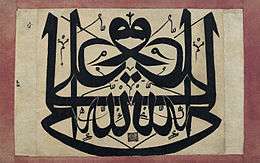Hadith of Jesus Praying Behind Mahdi
| Part of a series on |
| Islam |
|---|
 |
|
Related topics |
|
| Part of a series on |
| Eschatology |
|---|
|
|
| |
|---|
 |
|
|
Hadith of Jesus Praying Behind Mahdi (Persian: حدیث نماز خواندن عیسی به امامت مهدی) refers to a collection of narrations related about the prophecy that Jesus will follow Mahdi's lead in salat (prayer) after he descends. Mahdi is the twelfth Imam of the Shia muslims and salat is the Islamic practice of worship of God which muslims perform five times a day. The prophecy is narrated in numerous hadith collections. A total of 29 Hadiths relate the return of Jesus, and his prayer with Mahdi's lead.[1]
Background
Hadith are collections of the reports claiming to quote what the prophet Muhammad said verbatim on any matter.[2] The term comes from the Arabic meaning "report", "account" or "narrative". Hadith are second only to the Quran in developing Islamic jurisprudence,[3] and regarded as important tools for understanding the Quran and commentaries (tafsir) on it.
The hadith literature is based on spoken reports that were in circulation in society after the death of Muhammad. Unlike the Quran itself, which was compiled under the official direction of the early Islamic State in Medina,[4] the hadith reports were not compiled by a central authority. Hadith were evaluated and gathered into large collections during the 8th and 9th centuries, generations after the death of Muhammad, after the end of the era of the "rightful" Rashidun Caliphate, over 1000 km from where Muhammad lived.
Each hadith is based on two parts, a chain of narrators reporting the hadith (isnad), and the text itself (matn).[5][6] Individual hadith are classified by Muslim clerics and jurists as sahih ("authentic"), hasan ("good") or da'if ("weak").[7] However, there is no overall agreement: different groups and different individual scholars may classify a hadith differently.
Hadith
| Part of a series on |
|
A narration attributed to Abu Hurairah reports:This hadith has been narrated on the authority of Abu Hurairah that I heard the Prophet said:: 'What will be your condition when the son of Mary will come down to you and your Imam will be from amongst you'"[8]
Allamah Sayyid Sa'eed Akhtar Rizvi quotes the above tradition in his book "Muhammad (S) is the Last Prophet" and concludes:
This refers to the fact that prophet Jesus (a.s.) will not lead in the prayer, but the Imam of the Muslims who will leading them will lead in the prayers, and prophet Jesus will follow him.[9]
A narration attributed to Jabir ibn Abd Allah reports:This hadith has been narrated on the authority of Jabir Ibn Abdillah al-Ansari that I heard the Messenger of Allah saying: "A group of my Ummah will fight for the truth until near the day of judgment when Jesus, the son of Marry, will descend, and the leader of them will ask him to lead the prayer, but Jesus declines, saying: "No, Verily, among you Allah has made leaders for others and He has bestowed his bounty upon them."[10][11][12]
Abu Ya’ala provides another version of this hadith in his musnad with more clear terms.
A narration attributed to Jabir ibn Abd Allah reports:This hadith has been narrated on the authority of Jabir Ibn Abdillah al-Ansari that the Messenger of Allah said: "A group among my Ummah will continue to fight for the truth until Jesus, the son of Marry, will descend, and the Imam of them will ask him to lead the prayer, but Jesus replies: "You have more right to it, and verily Allah has honored some of you over others in this Ummah." [13]
A narration attributed to Al-Husayn Al-Ajiri reports:The traditions of al-Mustafa (S) on the rising of al-Mahdi has been transmitted via numerous authorities and is more than the level of (being sufficient for) Mutawatir, describing that he is of his Ahlul-Bayt, and will fill the earth with justice, and that Jesus (as) will come at the same time and he will assist Jesus for killing al-Dajjal in the land of Palestine, and that he will lead this nation and Jesus will pray behind him.[14]
A narration attributed to Sa'id ibn Jubayr reports:It is narrated from Ibne Abbas that the Messenger of Allah (a.s) said, “My Caliphs and successors are twelve persons, first of whom is my brother and the last my great grandson.” He was asked, “O Allah’s Messenger! Who is your brothera” He replied, “Ali bin Abi Talib.” He was asked, “Who is your great grandsona” He replied, “Mahdi, who shall fill the earth with justice and equity like it would be fraught with injustice and oppression. By the One in Whose hands is my life! Even if a day remains for the earth, the Almighty Allah will prolong this day till my son, Mahdi reappears and Isa bin Maryam descends to the earth and recites prayer behind His Eminence. The earth shall be illuminated from the east to the west.[15]
Interpretation
There is a belief among Shia Muslims that Jesus and the Mahdi will be both present at the same time, that the leaders who will carry out their commands will be from the Quraysh tribe, and that afterward Jesus will be the Vizier of the Mahdi. It's also believed that he will perform the prayer behind Mahdi and follow him.[1] Jalaluddin al-Suyuti writes in his Nuzool Isa Ibn Maryam Akhir al-Zaman[16] that:
I have heard some of the deniers of (truth) deny what has been conveyed about Jesus that when he descends will pray the Fajr prayer behind al-Mahdi. They say, Jesus has higher status than to pray behind a non-Prophet.This is a bizarre opinion since the issue of prayer of Jesus behind al-Mahdi has been proven strongly via numerous authentic traditions from the Messenger of Allah, who is the most truthful.[17]
See also
- Mahdi
- Jesus in Islam
- Hadith of position
- Hadith of the Twelve Successors
- Hadith of the two weighty things
References
- 1 2 Harun Yahya (July 2010). The Prophet Jesus (as) and Hazrat Mahdi (as) Will Come This Century (First ed.). Turkey: GLOBAL PUBLISHING. Retrieved 9 June 2014.
- ↑ Abou El Fadl, Khaled (22 March 2011). "What is Shari'a?". ABC RELIGION AND ETHICS. Retrieved 20 June 2015.
- ↑ Ibn Hajar, Ahmad. al-Nukat ala Kitab ibn al-Salah, vol. 1, p. 90. Maktabah al-Furqan.
- ↑ Cambridge Companion to the Quran. p. 62.
- ↑ Newby, Gordon D. (2002). A concise encyclopedia of Islam (Repr. ed.). Oneworld. ISBN 1851682953.
- ↑ Islahi, Amin Ahsan (1989 (tr:2009)). Mabadi Tadabbur-i-Hadith (translated as: Fundamentals of Hadith Interpretation) (in Urdu). Lahore: Al-Mawrid. Retrieved 2 June 2011. Check date values in:
|date=(help) - ↑ The Future of Muslim Civilisation by Ziauddin Sardar, 1979, page 26.
- ↑ Sahih Bukhari. p. Kitab Ahadithil Anbiya, Babu Nuzule Isa.
- ↑ Allamah Sayyid Sa'eed Akhtar Rizvi. Muhammad (S) is the Last Prophet. Islamic Republic of Iran: Bilal Muslim Mission of Tanzania. Retrieved 9 June 2014.
- ↑ Sahih Muslim (in Arabic). p. 193, part2.
- ↑ Musnad Ahmad ibn Hanbal (in Arabic). vol. 3.
- ↑ Jalaluddin al-Suyuti. Nuzool Isa Ibn Maryam Akhir al-Zaman (in Arabic). p. 57.
- ↑ Musnad by Abu Ya'la
- ↑ Ibn Hajar al-Haytami. Al-Sawa'iq al-Muhriqah. p. 254, Ch. 11, section 1.
- ↑ Fara'id al-Simtayn. p. 43.
- ↑ Jalaluddin al-Suyuti. Nuzool Isa Ibn Maryam Akhir al-Zaman. p. 56.
- ↑ Ahlul Bayt Digital Islamic Library Project Team. A Shi'ite Encyclopedia. Islamic Republic of Iran. Retrieved 9 June 2014.
